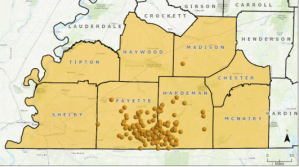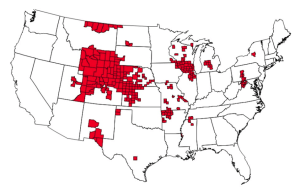MEMPHIS, Tenn. — A wildlife epidemic has been sweeping across the country this winter, and some officials in Tennessee said this “huge problem” is going to persist for a lengthy amount of time.
Chronic wasting disease (CWD) has been detected in deer in 251 counties in 24 states, according to the Center for Disease Control and Prevention. In Tennessee, 183 deer have tested positive — all but one were in Hardeman County or Fayette County.
Anthony Landreth, a West Tennessee hunter from Bolivar, found a deer on a hunt in southwest Hardeman County that clearly had CWD.
“When I first saw it, I thought, ‘Man, this thing is sick, bad,'” Landreth said of the deer he killed Jan. 20. “It was just skin and bones.”
Sure enough, it tested positive for CWD. He said he saw another deer just days later standing in water up to its waist in a pond, and he suspected that it also had CWD.

The Tennessee Wildlife Resources Agency (TWRA) sent a reminder Wednesday that feeding wildlife is prohibited in much of West Tennessee, including Shelby County, because of CWD.
So far, there are no known cases of the disease transmitting to humans, but the CDC recommends testing all killed deer to be safe. Jenifer Wisniewski, deputy director of communications with TWRA, said this issue is fairly new for Tennessee, but it is a problem people need to know about.
“You can’t kill it by cooking it or anything like that,” she said. “Prions (this type of disease) take like 7,000 degrees of heat before they’re killed, and cold doesn’t kill them either. It stays on the landscape forever because there’s nothing that kills it. Once it’s in a location, it’s going to be there.”
The first deer that tested positive for CWD in Tennessee was found in December 2018 in Hardeman County. Wisniewski said they have been testing deer in the state since 2002, but this was the first confirmed case in the state.
After Marshall County in Mississippi, which borders Tennessee, had deer test positive, TWRA increased their testing in the neighboring Fayette and Hardeman counties, which is when they found that first case.
So far, Mississippi has had 15 confirmed cases of CWD. Those have been in Marshall, Benton, Lee, Panola, Tallahatchie, Issaquena and Warren counties. Fifteen counties in Arkansas have seen 583 deer test positive, and all of those counties are in the northwest part of the state.

“It’s tragic, but it’s not an emergency that we have CWD,” she said. “It’s just a new hurdle that we’re going to have to overcome and keep in our management plan.”
She said it is illegal to carry deer carcasses across county or state lines without it being checked for CWD. Some states with a higher prevalence of CWD, like Wyoming, have seen about a 40 percent decline in deer population, but it is too early to tell if deer are declining in population due to the disease in Tennessee.
“People are spreading it by carrying deer from place to place,” Wisniewski said.
Wisniewski said there is about an 8 percent chance that deer killed in Fayette or Hardeman have CWD, but those areas are some of the most deer-populated areas in the entire state.
TWRA extended the hunting season in Fayette and Hardeman from Jan. 6 to Jan. 31 to allow hunters in those areas to collect more samples to test.
Landreth said it is not always clear if a deer has CWD without testing it, but sometimes it’s easy to tell. The deer could be in a “zombie state” and not move in a situation where a normal deer would be skittish, or they can look scrawny and weak at an age when they should be full of meat and muscles.
“Once a deer goes positive, they’re just about all dead within two years,” said Landreth, who is retired and spends most of his time hunting or fishing. “Some may die quicker than that. They could not really show symptoms for a long time. But once they do show symptoms of it, they don’t last too long.”
He said still within the hunting community, there is skepticism that CWD is just a “ploy” or a “conspiracy” to get money for the state, but Landreth said that is “so far from the truth.”
“CWD is a real disease, and CWD is in Tennessee, and in my opinion, CWD is here to stay because it’s been around since 1967 when it was found in Colorado,” he said.
Landreth said he knows that no cases of CWD have been confirmed in humans, but he won’t take any chances.
“Any deer that I kill, I would get tested from now on, as long as TWRA is still testing,” he said. “I won’t eat another deer until it gets tested.”























